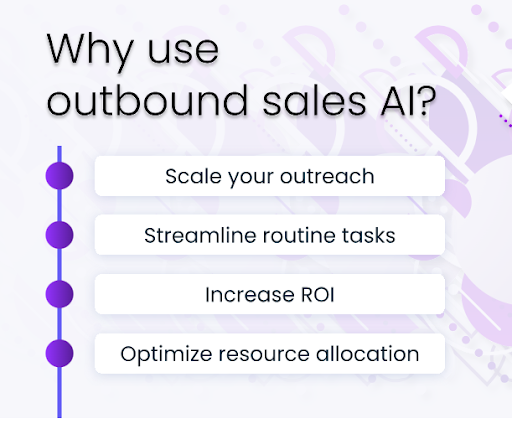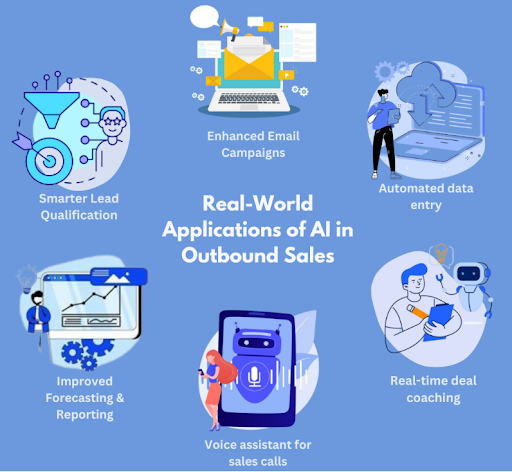What if, instead of manually checking lead lists, hunting for contact information, and guessing who might respond to an email, you simply ask the AI assistant, “Which prospects may convert this week? Display all the details.”
Within seconds, the system generates a list of customers who may convert, along with personalized insights that can help nurture each lead, recommend outreach strategies, and draft emails tailored to each individual. Modern tools can even act as an AI note taker, automatically recording and organizing insights from sales calls so no critical detail is missed.
Amazing right? This may be the reality of outbound sales in 2026. In fact, AI is transforming outbound sales strategies by reshaping how an outbound call center operates—making prospecting faster, smarter, and more data-driven than ever.
Traditionally, outbound sales were built on cold calls, cold emails, and manual prospecting. However, with the use of AI, outbound sales is shifting from guesswork to precision. However, with the use of AI, outbound sales is shifting from guesswork to precision. Sales teams can now even create images or visual assets that strengthen pitches, helping prospects better understand product benefits.
This article describes the role of AI in modern outbound sales, the benefits of AI in outbound sales strategies, and the future of outbound sales. As engagement evolves, innovations like an AI animation generator will allow reps to deliver dynamic product demonstrations that capture attention far more effectively than static presentations.
Let us begin.
The Role of AI in Modern Outbound Sales: How AI is Transforming Outbound Sales Strategies

Outbound sales used to be a long, manual process before the development and integration of AI. The outbound process was all about analyzing long lists, handling rejections, and manually adding entries. But using AI, all these tasks are automated. Salespeople can focus more on nurturing leads rather than doing these manual processes.
-
AI enhances prospecting and lead generation
The sales ratio is increased if there’s proper data analysis. AI-powered tools accurately analyze data points in seconds. Firmographics, buyer intent signals, job changes, funding rounds, or a prospect’s recent social media activity matter for accurate predictions.
Through the data that is collected about each prospect, once you know how a particular customer will convert, it becomes easy to nurture them using those techniques.
AI can find that an e-commerce brand hired a new CMO. The CMO has raised funding and is exploring the email marketing platforms. How is this information beneficial for your brand? Well, if you can help the CMO by automating their marketing tasks, then you can send a personalized email that interests him. Salespeople can focus on nurturing him rather than sending generic messages to see how he responds.
Using AI helps in achieving higher response rates and less wasted effort. Similarly, AI-driven SMS marketing can automate personalized outreach and follow-ups, enhancing customer engagement even further.
-
Smarter data analysis and decision making
Outbound sales generate exponential results if it’s done with insights. The traditional process mainly relied on gut instinct, or surface-level metrics like open rates, call volume, or average conversion percentages. The problem was that these numbers told you what happened, but couldn’t explain why it happened.
AI transforms this process by changing raw data into meaningful insights. Instead of waiting until the end of a quarter to review pipeline health, sales managers can now see real-time changes. They can view data like which deals are most likely to close? Which accounts are starting to disengage? Which reps need support on certain opportunities?
With an AI-powered customer data platform, AI can analyze patterns like how long a prospect spends on pricing pages, whether they interact with case studies, or if there’s any reduced engagement on emails. . These signals help in distributing prospects based on warm leads and cold leads. Understanding these distinctions is crucial, as addressing potential issues effectively can significantly reduce involuntary churn, ensuring a more stable customer base.
-
Reducing manual efforts for the sales team
Ask any sales rep what frustrates them the most? They might answer data entry tasks, repetitive outreach, and chase unresponsive leads. The good news is that AI is transforming outbound sales strategies and reducing this burden.
- No more manual list building: Instead of spending in finding out emails or verifying LinkedIn profiles, AI tools can find the data from databases in seconds.
- No more repetitive email drafting: AI-powered writing assistants generate personalized outreach messages as many as you want. For example, if a prospect published a blog post and got featured somewhere, then the AI can craft an introductory message around that news.
- No more wasted time on unresponsive leads: AI-driven lead scoring analyzes factors like engagement history, industry fit, budget indicators, and intent data to figure out the warm leads.
By eliminating repetitive tasks, AI helps reps to focus on sales skills such as building trust, creating value, and closing deals. And also you can consider leveraging an AI content summarizer to extract key insights from such articles and personalize your outreach with relevant context.
Benefits of AI in Outbound Sales Strategies

The impact of AI in outbound sales strategies saves time and transforms outcomes. Here are the benefits businesses are observing.
-
Improved conversion rates through personalization
The major drawback of outbound sales was impersonalized outreach. People used to receive generic and unwanted messages. This frustrated them at core, and it affected your brand image. But with AI sales team can create personalized messages based on the type of problems the prospect has.
Instead of sending the same email to 1000 prospects, reps can deliver unique messages that solve the prospect’s problem. For smaller businesses, pairing AI outreach tools with the best free email marketing software can be a cost-effective way to scale personalization without straining the budget.
This level of personalization used to be possible only for some accounts. Now, it’s available for the entire prospect list. And when prospects feel understood, conversions follow.
-
Faster response time for better engagement
In today’s competitive world, speed matters. If you won’t reach your customer, then someone else will. If there’s even a slight delay in handling customer queries, then they’ll move to your competitors and buy from them.
This is where integrations matter. Companies moving data seamlessly across platforms from Redshift to Zendesk are creating unified views of prospects, ensuring nothing slips through the cracks. It’s no longer just about contacting leads, but engaging them at the right moment with the right message.
-
Streamlines workflows and increases efficiency
The data from various sources is stored on various platforms. To fetch a particular data, reps had to switch between tools. This took up their time and decreased efficiency.
With AI, Outbound sales reps no longer need to toggle between endless tools. An AI Workflow Automation Software listed in Revoyant brings workflows, lead scoring, outreach sequencing, follow-ups, and reporting into one unified dashboard, allowing teams to operate faster without switching between multiple platforms.
For teams looking to streamline procurement and proposal processes, an AI RFP tool can automatically generate, analyze, and manage requests for proposals, reducing manual effort and improving response accuracy.
According to a report by SuperAGI, 78% of frequent AI users reported shorter deal cycles, 70% saw an increase in deal size, and 76% experienced higher win rates. These statistics show the benefits of incorporating AI into sales processes.
The Future of Outbound Sales With AI in 2026 and Beyond
As the AI capabilities are evolving, outbound sales will look more futuristic in the years ahead. Let us explore where we are headed:
-
Predictions on evolving AI capabilities
AI is already good at predicting insights, but what are we looking for? We’re looking at adaptive AI that learns from static as well as dynamic data. Imagine an AI system that analyzes a prospect’s tone of voice on a call, adjusts the sales script in real time, and suggests follow-up strategies that match their personality profile.
The integration of an AI voice API into outbound calling platforms will make sales conversations smarter and dynamic than ever before. This is often accomplished by leveraging a scalable virtual phone number that can be directly integrated with the AI voice API. Rather than relying solely on memory or scripts, sales reps now have real-time guidance during live calls. The AI listens to the conversation, analyzes the prospect’s tone, sentiment, and key phrases, and provides live prompts or suggestions on what to say next. For example, if a prospect expresses concern about pricing, the system can instantly suggest a tailored response highlighting value or alternative solutions.
This technology is used by a few businesses right now, but by 2026, it will be used by many.
Beyond just scripting, AI voice APIs can track engagement metrics, flag opportunities for upselling, and even suggest follow-up actions immediately after the call ends. This means reps can pivot in the moment, address objections more effectively, and deliver highly personalized conversations that feel natural rather than robotic. For sales teams, this improves the quality of each call and shortens the sales cycle, increases conversion rates, and ensures that every interaction is meaningful.
-
Integration with CRM and automation platforms
Outbound sales become powerful when the data is integrated into a system. In 2026, AI will be deeply embedded into CRMs, marketing automation tools, and customer success platforms. This interconnected system means sales teams no longer operate with fragmented data.
Suppose your CRM flags that a prospect visited your pricing page three times last week. For a dropshipping business, this could signal strong interest in a trending product, allowing sales teams to act quickly. The AI instantly updates a personalized pitch with the discount that can be sent to the prospect to persuade him to make a purchase.
-
How businesses can prepare to stay competitive
The companies winning in 2026 are adopting AI tools, partnering with top AI consulting companies, and rethinking their sales culture around AI. Here’s what leaders should prioritize:
- Invest in AI literacy: Ensure sales teams know how to leverage tools effectively, not just use them passively.
- Focus on data quality: AI is only as good as the data it feeds on. Clean, enriched data is non-negotiable.
- Balance tech with human touch: While AI handles efficiency, reps must double down on empathy and trust-building.
Businesses that fail to adapt risk being left behind in a marketplace where prospects expect speed, personalization, and intelligence in every interaction.
The AI-Powered Future of Outbound Sales is Here
AI has transformed outbound sales from a numbers game into a precision-driven strategy. AI enables smarter data analysis, predictive insights, automates repetitive tasks, personalizes outreach, and enables real-time call intelligence. Sales teams in 2026 will operate at levels of speed and efficiency that were not possible a few years back.
The takeaway is simple: the businesses winning today are those that embrace AI and leverage automation
If you’re ready to shorten sales cycles and increase deal values with personalized messaging, connect with Writecream today.
